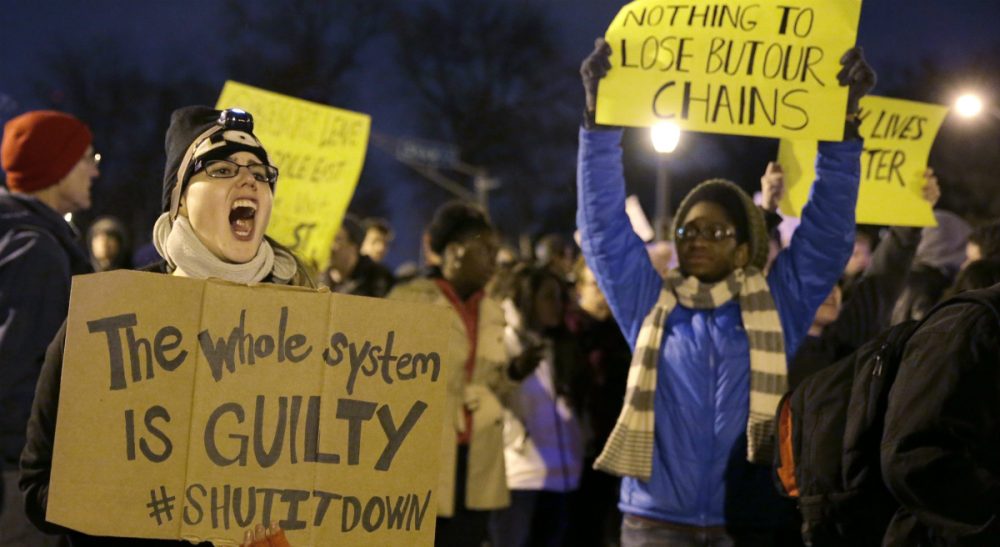Advertisement
The Unrest In Ferguson Is Terrible — Our Response Is Just As Bad

Last week’s looting and rioting in Ferguson have become burned into the public psyche. Early on, media images of liquor store raids and burning businesses dominated the airwaves, reinforcing timeworn, negative stereotypes about anti-social behavior in urban neighborhoods, and becoming cast in the public consciousness as the “black response.”
Not only does this do a terrible disservice to a legitimate conversation about race and justice in America, it is also seemingly the only version of the riots being discussed. As the subtle narrative goes, the rioting was done by those who are black and in poverty, seemingly because they are “black” and “poor.” Yet, the same behaviors could be ascribed to any of a number of other populations, including people who are white and affluent.
Why is anyone treating this like it’s specific to low-income, black residents in Ferguson? And why delegitimize concerns over the grand jury proceedings because a group of angry people self-selected to be out late at night and wreak havoc?
One can make a case that looting and rioting are human phenomena, resulting from a confluence of events such as weakened social control, a sense of reduction in the presence of the rule of law and, sometimes, loss of faith in a given system. Even large crowds laced with a few out-of-control individuals can be enough to trigger chaos.
No one of these factors alone necessarily explains rioting and violence, and certainly none justify it. The destruction of businesses and of public spaces is an indictment of those who participated. That is not the same thing, however, as indicting a segment of the American population based on the actions of a relative few.
It’s time to stop treating the disorder as a 'black' response, rather than a human response.
A week before the grand jury's decision not to indict Officer Darren Wilson in the death of Michael Brown, I noted to my students that when communities perceive cracks in social control, disinhibited behavior can ensue. Think Mardi Gras, for example, on one end of the continuum, and sports hooliganism a further down.
If you combine additional factors, such as great uncertainty or great public emotion, things can get even worse. Take, for example, the 2004 Boston Red Sox win in the World Series. Public emotion doesn’t get much greater than that. Reporting on the aftermath of the victory, Reuters described people “hurling rocks at police in riot gear, smashing windows and lighting fires.” Ultimately, a pepper spray pellet fired by police killed a white, female participant in the disorder.
Now imagine a weakened sense of the rule of law. In the case of Ferguson, that was represented by severe distrust between residents and police. History offers plenty of other examples. In 1919, when Boston Police went on strike. Over a two-night period, Bostonians intimidated people on the streets, smashed windows and property, and looted stores. People were killed by gunfire in South Boston and Scollay Square. Order was restored only when the National Guard arrived. This last point is of note because Missouri Governor Jay Nixon had activated the National Guard, but did not deploy it in advance of the grand jury announcement. According to the St. Louis Post-Dispatch, “Nixon has been castigated all week for the National Guard’s late response in Ferguson.”
Advertisement
And sometimes, people riot for absolutely no reason at all. This past October, fraternity parties near Keene State College in Keene, N.H., turned into into public mayhem during the town’s annual pumpkin festival — yes, a pumpkin festival. During the melee, according to the Boston Globe, “rioters smashed windows, slashed tires and overturned Dumpsters.”
Lastly, imagine the compounding effects of believing a system that was supposed to protect and care for you instead failed you utterly. Where are the incentives to uphold that system for others? During the Great Depression, people committed runs on banks in most major American cities, including Boston, despite understanding that it would only make things worse.
It’s time to stop referring to the Ferguson rioters as “protestors,” delegitimizing countless effective, non-violent protests across America. It’s time to stop treating the disorder as a “black” response, rather than a human response. The behavior was wrong, but absolutely not a mystery, and not remotely unique to the people of Ferguson, to urban black America, or to poor people of color.
Related:
